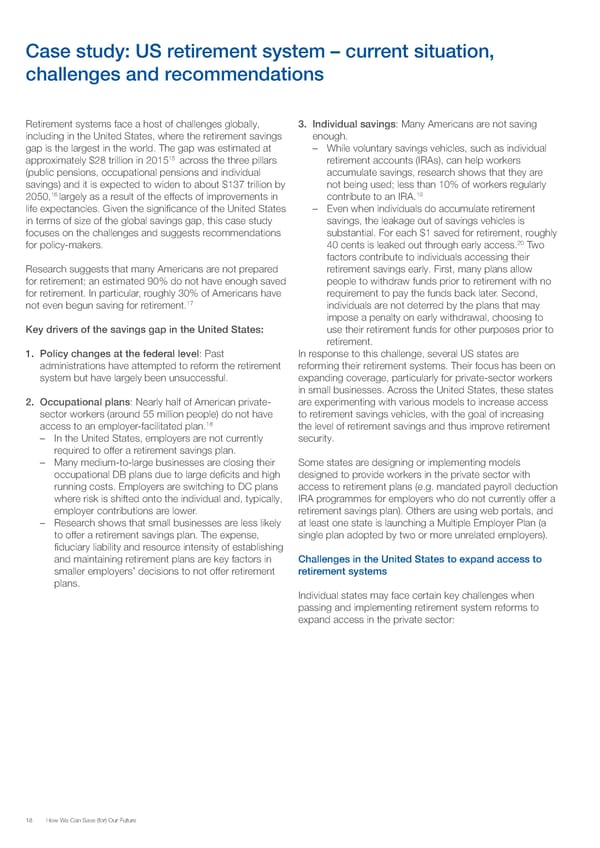Case study: US retirement system – current situation, challenges and recommendations Retirement systems face a host of challenges globally, 3. Individual savings: Many Americans are not saving including in the United States, where the retirement savings enough. gap is the largest in the world. The gap was estimated at – While voluntary savings vehicles, such as individual 15 approximately $28 trillion in 2015 across the three pillars retirement accounts (IRAs), can help workers (public pensions, occupational pensions and individual accumulate savings, research shows that they are savings) and it is expected to widen to about $137 trillion by not being used; less than 10% of workers regularly 16 19 2050, largely as a result of the effects of improvements in contribute to an IRA. life expectancies. Given the significance of the United States – Even when individuals do accumulate retirement in terms of size of the global savings gap, this case study savings, the leakage out of savings vehicles is focuses on the challenges and suggests recommendations substantial. For each $1 saved for retirement, roughly 20 for policy-makers. 40 cents is leaked out through early access. Two factors contribute to individuals accessing their Research suggests that many Americans are not prepared retirement savings early. First, many plans allow for retirement; an estimated 90% do not have enough saved people to withdraw funds prior to retirement with no for retirement. In particular, roughly 30% of Americans have requirement to pay the funds back later. Second, not even begun saving for retirement.17 individuals are not deterred by the plans that may impose a penalty on early withdrawal, choosing to Key drivers of the savings gap in the United States: use their retirement funds for other purposes prior to retirement. 1. Policy changes at the federal level: Past In response to this challenge, several US states are administrations have attempted to reform the retirement reforming their retirement systems. Their focus has been on system but have largely been unsuccessful. expanding coverage, particularly for private-sector workers in small businesses. Across the United States, these states 2. Occupational plans: Nearly half of American private- are experimenting with various models to increase access sector workers (around 55 million people) do not have to retirement savings vehicles, with the goal of increasing 18 access to an employer-facilitated plan. the level of retirement savings and thus improve retirement – In the United States, employers are not currently security. required to offer a retirement savings plan. – Many medium-to-large businesses are closing their Some states are designing or implementing models occupational DB plans due to large deficits and high designed to provide workers in the private sector with running costs. Employers are switching to DC plans access to retirement plans (e.g. mandated payroll deduction where risk is shifted onto the individual and, typically, IRA programmes for employers who do not currently offer a employer contributions are lower. retirement savings plan). Others are using web portals, and – Research shows that small businesses are less likely at least one state is launching a Multiple Employer Plan (a to offer a retirement savings plan. The expense, single plan adopted by two or more unrelated employers). fiduciary liability and resource intensity of establishing and maintaining retirement plans are key factors in Challenges in the United States to expand access to smaller employers’ decisions to not offer retirement retirement systems plans. Individual states may face certain key challenges when passing and implementing retirement system reforms to expand access in the private sector: 18 How We Can Save (for) Our Future
 How can we save for our future Page 17 Page 19
How can we save for our future Page 17 Page 19